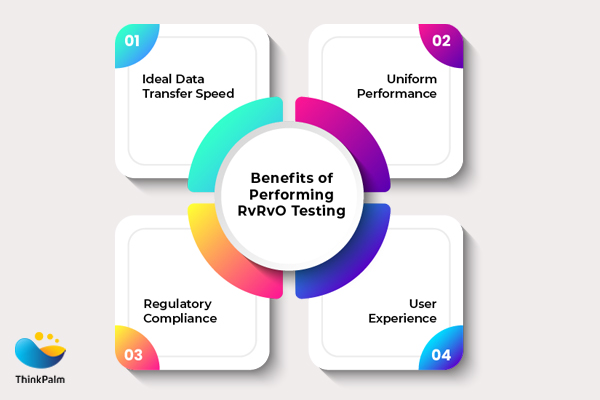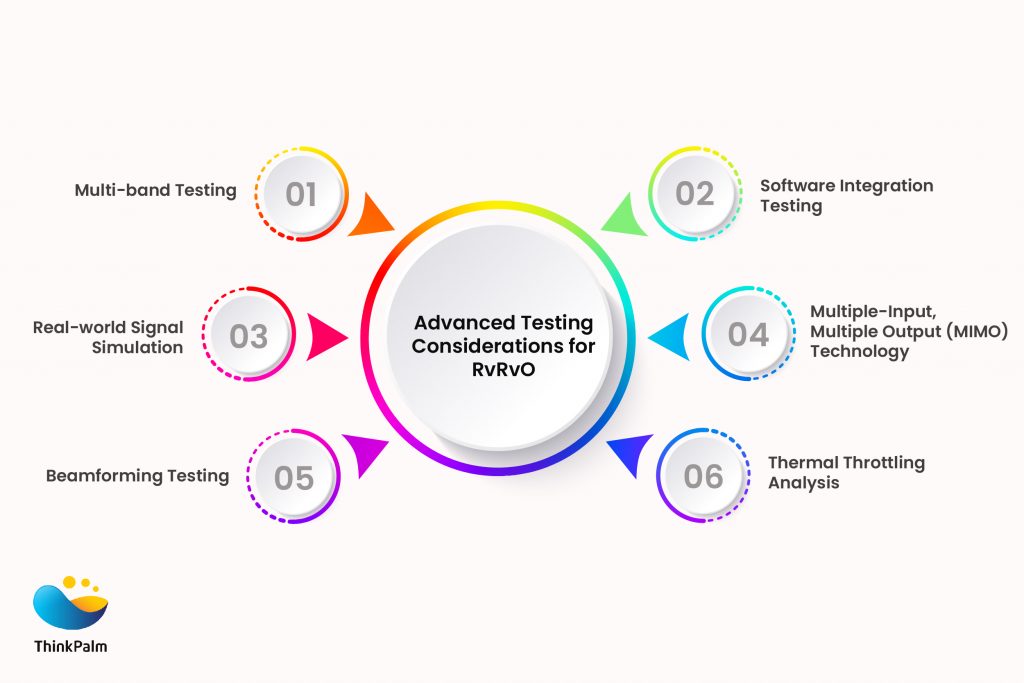The Rate vs. Range vs. Orientation (RvRvO) test is a pre-compliance test conducted on wireless devices to ensure they function optimally under various real-world conditions. It essentially tests three key factors that can affect the performance of your device’s wireless signal: data transfer speed, distance, and physical orientation of a wireless device.
Now that we understand why a wireless device manufacturer should implement pre-compliance testing, we shall discuss the Rate vs. Range vs. Orientation (RvRvO) test. This test is one of the few important tests performed in the TR-398 test suites under pre-compliance testing.
In this article, we shall discuss the RvRvO test and why it is crucial, the advanced testing considerations, its benefits, and so on. So, let’s start by understanding RvRvO testing.
Today, in this interconnected environment, reliable wireless performance is more inevitable than before. As per the statistics from marketsandmarkets.com, the wireless testing market is projected to grow from USD 22.6 billion in 2024 to USD 34.1 billion by 2029.
From streaming videos to transferring large files flawlessly, we need strong wireless connections.
However, several interferences affect the wireless signal strength and performance. Finally, this leads to poor data transfer rates. At this juncture, the RvRvO test comes in.
The RvRvO test is one of the pre-compliance tests in the TR-398 series. It optimizes the working of wireless devices in real-world situations. The test fundamentally evaluates three critical factors that impact the performance of the wireless signal of a device under test (DUT).
Let’s break it down.
Rate is the DUT’s data transfer speed. It verifies changes in the rate when the signal strength becomes feeble as the distance increases or due to any other hindrance.
The Range assesses the maximum distance the DUT can maintain a usable and stable connection without affecting performance. It mimics the signal weakening once the distance between the DUT and the access point increases.
It verifies the connection between the physical orientation of DUT and the signal strength. Also, it measures the changes in signal quality and speed at which data transfer occurs when you hold the device in different positions.
Typically, wireless signals are easily influenced by physical hindrances such as buildings, concrete walls, metal and glass panels, and, of course, distance as well.
The fundamental purpose of the RvRvO test is to identify possible issues with the ability of DUT to manage real-world conditions. Therefore, the RvRvO test exposes the weaknesses in relation to the DUT’s wireless performance.
Imagine experiencing buffering in videos or slow download speeds when you are not close to your Wi-Fi device. It can even be because you hold your phone in some direction. It is interesting to note that these trivial factors never seem to affect wireless performance, but often they do.
The RvRvO test helps manufacturers address the problems in advance. Also, it ensures that your device can deliver the best wireless performance in real-world scenarios.
RvRvO Testing offers several benefits that optimize the performance of wireless devices. Let’s discuss a few of the most significant benefits of RvRvO testing.
DUTs achieve high data transfer rates, helping to reduce any lag or buffering. The test verifies and tracks the changes in data transfer rate under changing conditions, for example, due to distance, physical barriers, and device orientation. It helps recognize issues that lead to considerable delays.
The RvRvO test recognizes wireless performance under varying conditions based on rate, range, and device orientation. Therefore, knowing the areas where the data transfer speed weakens considerably, device manufacturers can provide solutions. Furthermore, it ensures reliable and consistent data transfer rates, ensuring uniform performance for every user.

Wireless devices must comply with specific signal strength and performance standards in accordance with regulatory requirements. The RvRvO test helps ensure that DUT meets the standards set up by top regulatory authorities in the wireless field before it reaches the markets.
The primary objective of every wireless device is to offer a flawless user experience. RvRvO tests ensure that users do not have concerns over dropping connection or lagging because of common reasons such as barriers, distance or the physical orientation of the DUT.
In essence, the RvRvO test assumes a key role in pre-compliance testing as it mimics real-world scenarios. The test identifies potential issues in regard to the DUT’s wireless performance.
Therefore, it enables device manufacturers and developers to update their designs during the development phase to make sure that their devices offer optimal performance in different usage conditions.
The RvRvO test is held in a controlled environment, using specialized equipment to simulate varying signal conditions. Let’s take a quick look at how ThinkPalm performs the RvRvO testing.
We shall break down the five step process in RvRvO testing.
The first and foremost step is to set up the testing environment. At this initial stage, the device is placed inside a chamber, which reduces interference and signal reflections.
At a certain distance, the DUT is connected to a signal source. The signal strength is weakened slowly, and data transfer rates are measured. The test helps analyze how the device performs under changing signal conditions.
In this, pen testers increase the distance between the device and the signal source systematically. At the same time, a constant signal strength is maintained during the test. The test measures the maximum distance at which the DUT can provide a reliable and stable connection.
Under Orientation testing, the device is placed in different orientations, such as vertical and horizontal positions, maintaining a specific distance and signal strength. While the DUT is in different orientations, the test assesses the changes in signal strength and data transfer speed.
The final step in the RvRvO test is to analyze the data collected from all these tests. The purpose is to identify the issues in performance associated with connection stability, data transfer speed, and the implications of physical orientation.
In this phase, a complete report is generated to list the results from the test and includes recommendations for improving performance as well.
The key principles governing RvRvO testing remain the same. In addition to this, there are some advanced testing aspects that can enhance the entire process. It includes:
Today, wireless devices support multiple frequency bands, such as 2.4GHz and 5GHz. RvRvO testing is conducted on each band to analyze the performance change across several frequencies. The 2.4GHx band is vulnerable to interference from other devices, but it provides a wider range compared to 5GHz.
On the other hand, 5GHz has a faster data transfer rate but features a shorter range. Further, it gets blocked by obstacles. Regardless of the user’s environment, testing on both frequencies helps optimize performance.
For devices with built-in software to handle wireless connections, it is easy to integrate the software testing process. Therefore, it helps with a complete evaluation of a DUT’s performance.
Further, it ensures that both the software and hardware operate seamlessly together. It optimizes wireless connectivity as well.
Advanced testing considerations incorporate chambers that can simulate real-world signal conditions.
In a very realistic setting, these chambers use physical obstacles such as walls and electronic devices to check how they affect the signal quality and data transfer speed. In other words, they offer useful insights into how efficiently a device will perform in real-world situations.

MIMO uses multiple antennas on the DUT and access points for transmitting and receiving data simultaneously.
Advanced approaches in RvRvO testing assess the performance of the DUT with MIMO setup. Further, it ensures that the DUT can use this remarkable technology to improve data throughput and signal stability.
Beamforming is a method by which the router sends signals directly to a specific device it communicates with instead of sending them all over.
In advanced RvRvO testing, we assess the effectiveness of a DUT’s interaction with beamforming signals. Additionally, it ensures a stable and stronger connection.
Analyses how the temperature of the DUT impacts its Wi-Fi performance.
Thermal monitoring in advanced RvRvO testing evaluates the impact of thermal throttling on device performance under continuous usage situations. Above all, it helps understand the design improvements required during high activity.
Therefore, RvRvO testing provides complete and insightful results using these advanced approaches. It enables device manufacturers to recognize and address any weaknesses across several real-world scenarios. Moreover, it aims at creating devices that offer the best, reliable and robust wireless performance for end users.
Frequently Asked Questions:
What is RvRvO testing?
RvRvO represents Rate vs. Range vs. Orientation Testing. It’s a complete pre-compliance testing that assesses a DUT’s Wi-Fi performance under varying conditions. It fundamentally looks into factors such as data transfer speed, signal strength, physical orientation, obstacles, and so on.
What are the benefits of RvRvO testing?
It identifies and addresses Wi-Fi issues much earlier, optimizes device design, ensures a smooth end-user experience, and helps manufacturers gain a competitive advantage by helping wireless devices perform the best.
What is the process after RvRvO testing?
ThinkPalm provides a complete report of test results with details of performance issues identified, performance metrics under varying conditions, and useful recommendations for improvement. It helps device manufacturers to optimize the performance of their devices.
How is ThinkPalm’s RvRvO testing different from other providers?
ThinkPalm focuses on a collaborative approach, working closely with clients to gain a clear understanding of the product objectives and customize the testing process. Further, the expertise and advanced testing facilities allow manufacturers to gain reliable and useful insights for enhancing their devices’ Wi-Fi performance.
The digital ecosystem necessitates reliable and stable wireless connectivity. With ThinkPalm’s RvRvO testing, you can ensure your wireless devices fulfill all the expectations.
Your device gets subjected to rigorous pre-compliance testing for recognizing and addressing potential problems associated with data transfer speed, connection stability and physical orientation.
It’s all about ensuring a user-friendly wireless experience. ThinkPalm’s RvRvO testing is a vital tool for manufacturers to ensure they offer high-performing wireless devices. Connect with us to take your device performance to the next level and make your end users happy!